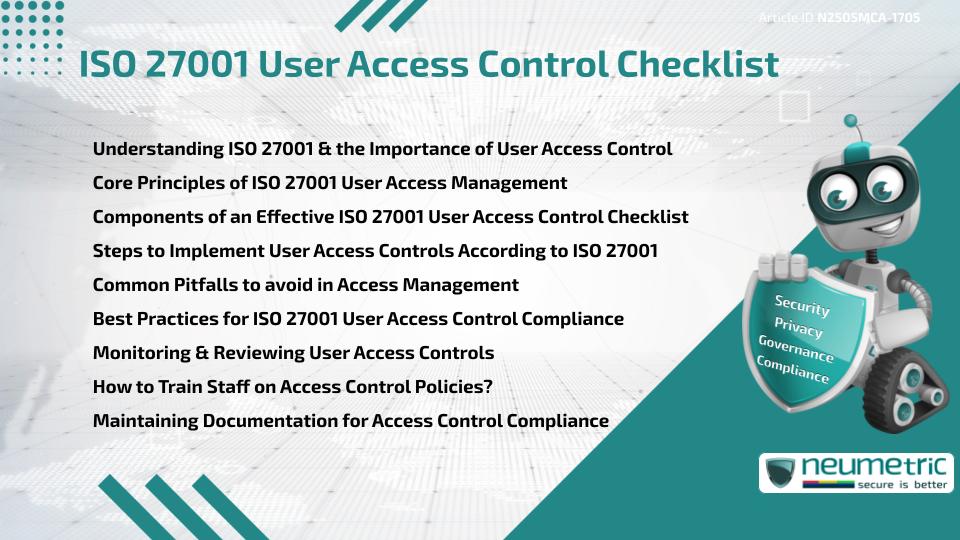Table of Contents
ToggleIntroduction
Managing who can access what within an organisation is one of the most important parts of securing information. Under the ISO 27001 Framework, this responsibility is structured & audited through a detailed & repeatable process known as User Access Control. The ISO 27001 User Access Control checklist helps Organisations define, enforce & monitor access rights in alignment with their Information Security Management System [ISMS].
This Article provides a complete breakdown of the ISO 27001 User Access Control checklist—explaining what it includes, how to implement it & why it matters.
Understanding ISO 27001 & the Importance of User Access Control
ISO 27001 is an International Standard that outlines Best Practices for establishing, implementing & maintaining an effective ISMS. A core part of this standard involves managing how access to sensitive Systems & Data is granted & controlled.
User Access Control prevents unauthorised exposure or misuse of business information. Poor access management may result in security breaches, compliance failures or even internal misuse. This is why ISO 27001 explicitly requires organisations to manage User access securely & consistently through clearly defined Policies & Technical Controls.
Core Principles of ISO 27001 User Access Management
The ISO 27001 User Access Control checklist is designed around several fundamental principles:
- Need-to-Know Access: Users should only have access to the information required for their job functions.
- Role-Based Access Control [RBAC]: Assign access privileges according to user roles to ensure consistent permission handling.
- Least Privilege: Assign only the essential access required to complete a task.
- Segregation of Duties: Divide essential tasks to help minimise the potential for misuse or fraudulent activities.
- Timely Revocation: Access must be promptly revoked when no longer required.
These principles support both Compliance & Risk Mitigation strategies.
Components of an Effective ISO 27001 User Access Control Checklist
An ISO 27001 User Access Control checklist typically includes the following elements:
- User Account creation & authorisation Procedures
- Access Control Policies & acceptable use agreements
- Role-based access mapping
- Multi-factor authentication & secure login Policies
- Regular review & Audit of access privileges
- Termination procedures for revoked or expired access
- Recordkeeping & documentation
- Training for users & administrators
Each element serves a clear purpose in securing systems & aligning with ISO 27001 Annex A controls such as A.9 (Access Control).
Steps to Implement User Access Controls According to ISO 27001
To adopt the ISO 27001 User Access Control checklist effectively:
- Define Roles & Responsibilities: Establish who approves, implements & audits Access Controls.
- Create an Access Control Policy: Document how User access will be granted, reviewed & revoked.
- Implement Technical Controls: Set up tools & systems for role management, authentication & access logging.
- Train Staff: Ensure that Employees understand the Policies & Procedures relevant to their role.
- Review Periodically: Schedule regular Audits of access rights to confirm their appropriateness.
- Update as Needed: Adjust access when roles change or when Security Incidents occur.
Each of these steps should be tailored to organisational size, complexity & industry-specific Risks.
Common Pitfalls to avoid in Access Management
Many organisations struggle to fully implement the ISO 27001 User Access Control checklist due to:
- Over-permissioning users “just in case”
- Delays in revoking access after Employee exit
- Lack of documentation or tracking for changes
- Infrequent Audits or Reviews
- Using shared or generic accounts
Avoiding these mistakes is key to preventing internal & external data breaches.
Best Practices for ISO 27001 User Access Control Compliance
Here are some widely accepted strategies to strengthen your implementation of Access Controls:
- Use automated identity & access management tools where possible
- Enforce strong password & authentication Policies
- Allocate individual user IDs to maintain clear accountability
- Integrate Access Controls into your onboarding & offboarding processes
- Document all access permissions & changes
Consistency & accountability are essential in creating a defensible Access Control system.
Monitoring & Reviewing User Access Controls
The ISO 27001 User Access Control checklist includes guidance on regular reviews. At least annually—or whenever a major organisational change occurs—you should:
- Audit User access against job roles
- Remove outdated or unused accounts
- Validate that role permissions reflect current responsibilities
- Log all changes to access settings for traceability
Monitoring Tools such as SIEM (Security Information & Event Management) can help automate & strengthen this process.
How to Train Staff on Access Control Policies?
A checklist is only effective if people follow it. Training should cover:
- Acceptable use of credentials
- Phishing & password hygiene
- Access request & escalation Procedures
- Consequences of Policy violations
Interactive learning tools & periodic refresher courses can increase retention & accountability.
Maintaining Documentation for Access Control Compliance
Maintaining clear & accessible records helps demonstrate ISO 27001 Compliance during Audits. You should store:
- Access Control Policies & Procedures
- Change logs of access updates
- Records of access Reviews & Audits
- User training completion certificates
Using a unified documentation system can strengthen your compliance efforts & lessen the workload on administration.
Takeaways
- The ISO 27001 User Access Control checklist is essential for protecting Sensitive Data.
- It includes role definitions, Policies, Technical Controls & Audits.
- Effective implementation reduces Risk & ensures ISO 27001 Compliance.
- Regular reviews, documentation & user training are key to maintaining security.
- Avoid common mistakes like over-permissioning & missed revocations.
FAQ
What is included in an ISO 27001 User Access Control checklist?
It includes User provisioning, role definitions, access Policies, Audits, Authentication Controls & Documentation requirements.
How often should User access be reviewed?
User access should be reviewed at least annually or after major changes in role, structure or system configuration.
Is role-based access necessary for ISO 27001?
Yes, role-based access ensures users have the right permissions & supports the principle of Least Privilege under ISO 27001.
Are shared user accounts allowed under ISO 27001 Access Control rules?
No, using shared accounts weakens individual accountability & tracking, both of which are critical to meeting ISO 27001 Access Control requirements.
What steps should be taken to remove access when an Employee exits?
Follow a structured exit Procedure that ensures quick removal of all system & data access, along with timely updates to the Access Records.
What documentation should be maintained for Access Control?
Policies, change logs, review records & training certificates should all be documented to meet ISO 27001 requirements.
Is training staff part of Access Control requirements?
Yes, ISO 27001 expects that users are aware of & follow Access Control Policies relevant to their roles.
Can automated tools help with ISO 27001 User Access Control checklist Compliance?
Yes, tools like IAM platforms can help automate provisioning, role assignment & review workflows.
Need help?
Neumetric provides organisations the necessary help to achieve their Cybersecurity, Compliance, Governance, Privacy, Certifications & Pentesting goals.
Organisations & Businesses, specifically those which provide SaaS & AI Solutions, usually need a Cybersecurity Partner for meeting & maintaining the ongoing Security & Privacy needs & requirements of their Clients & Customers.
SOC 2, ISO 27001, ISO 42001, NIST, HIPAA, HECVAT, EU GDPR are some of the Frameworks that are served by Fusion – a centralised, automated, AI-enabled SaaS Solution created & managed by Neumetric.
Reach out to us!


